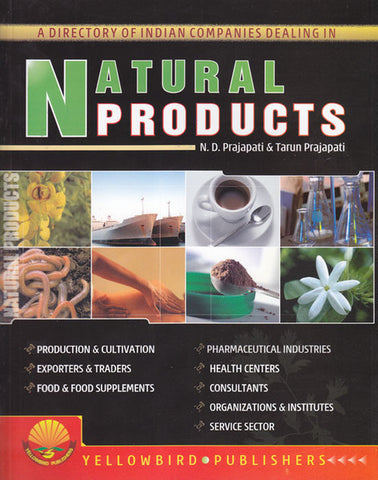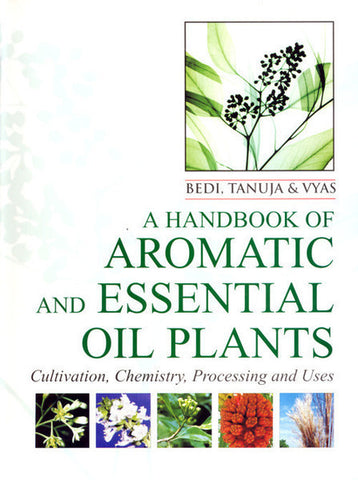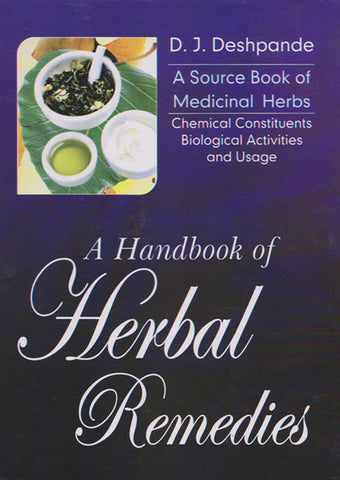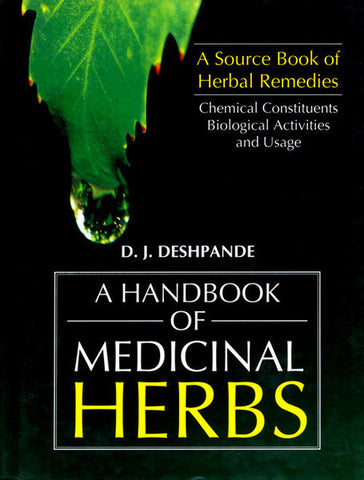AUTHOR: Arun K. Sharma
ISBN: 9788177540994
YEAR: 2013
PAGES: 627
BINDING: Hard
LANGUAGE: English
In this handbook almost all the aspects related to organic farming has been covered with the balanced approach. The author demonstrates the newness of the organic concept for readers. This will help the readers to discover easily the philosophical and technical differences between organic and conventional farming systems.
Chapter 1 deals with the need and progress towards sustainable farming system. In Chapter 2 various rules and regulation related to soil and crop management for standard organic farming. Chapter 3 gives basic information about soil environment in relation to plant growth, Various basic and applied aspects of input and crop health management are discusses in chapter 3 to 12. The author raised serval issues and concerns, specially on adoption, marketing and research in organic fanning in chapter 14 to 16. Considering the fast development in technology and marketing in organic farming, detailed list of electronic sources is included in the end.
This handbook will serve as a complete source book for the researchers, scientist, farmers and students working on organic concept.
Arun K. Sharma is a graduate from G.B. Pant University of Agric. & Tech., Pantnagar and presently working as Scientist at Central Arid Zone Research Institute, Jodhpur. He has worked on rainwater conservation and development of self-sustainable farming systems for drylands. He is the founder member of International Society of Organic Agriculture Research (ISOFAR). He has visited Germany and Japan and delivered his research papers in national and international conferences. He has written two internationally known books namely, A Handbook of Medicinal Plants: A Complete Source Book and Biofertilizers for Sustainable Agriculture. His book Javik Khati: Navi Disha (Sajivee, Saral, Satat) has been awarded by the President of India Pratibha Devi Singh Patil for scientific hindi writing.
Chapter 1: CYCLE FOR SURVIVAL
1. The Green Revolution-Unsustainable impact
2. Impact of Advanced Agricultural Technology Hazards
a. Adverse Effects of Agricultural Practices on the Farm
i. Soil Erosion
ii. Water Availability
iii. Salinization
iv. Fertilizer and Pesticide Contamination
v. Genetic Erosion
b. Adverse Effects of Agricultural Practices Away from the Farm
i. Soil Erosion
ii. Fertilizer and Pesticide Contamination
iii. Socio-Economic Values
iv. Economic and Political Issues
v. Environmental Accounting
vi. Food Security
c. Sustainable Agriculture: Need of the Hour
i. Evolution of Sustainable Agriculture
1. Sustainable Livelihood
d. Other Eco-Friendly Farming Systems
i. Organic Farming
ii. Biological Farming
iii. Nature Farming
iv. Regenerative Agriculture
e. Permaculture
f. Alternate Agriculture
g. Ecological Agriculture
h. Ecological Farming Systems
i. Objectives of Ecological Farming
ii. Prospects
i. Integrated Intensive Farming System (IIFS)
j. Low External Input Supply Agriculture (LEISA)
i. Low-Input Agriculture
ii. Criteria for LEISA
k. Biodynamic Agriculture
i. Organic Farming vs. Biodynamic Farming
ii. Principles of Biodynamic Farming
iii. Rules for using Biodynamic Agriculture
iv. Few Biodynamic Preparations .v
v. Research Achievements in Biodynamic Farming
l. Permaculture Farming
i. Meaning and Objectives of Permaculture Farming
m. Organic Agriculture System
i. The Major Aims of Organic Farming
ii. Concept of Organic Farming
iii. Difference Between Organic and Conventional Farming
iv. History of Organic Farming
v. Needs of Organic Farming
n. Conclusion
Chapter 2: TOWARDS ORGANIC FARMING
1. Management of Autonomous Ecosystem
a. Mixed Farming
i. Plants
ii. Animals
iii. Soils
iv. Biosphere
b. Crop Rotation
i. Benefits of crop diversification
c. Organic Cycle Optimization
d. In Partnership with Nature
2. Basic Standards and General Principles for Organic Agriculture
a. Crop and Soil Management
b. Choice of Crops and Varieties
c. Crop Rotations
d. Fertilization Policy
e. Management of Pests, Diseases and Weeds
f. Wild Products
g. Pollution Control
h. Soil and Water Conservation
i. Landscape
3. Principle Requirements and Pre-conditions
4. Conversion from Conventional to organic Farming
a. Farms with plant production and livestock
b. Limitations
c. Initiating organic farming
i. Medicinal plants-the First Crops for Organic Farming
5. Management of Permaculture Farm
a. Permaculture Farm
i. Use of Draft Animal
ii. Making Permanent Farm
iii. Improvement of the Soil
iv. How to bury Organic Matter
v. Mixed Cropping
b. Permaculture for Wastelands
i. Soil and water conservation
ii. Pioneers
iii. Secondary species
c. Conclusion
Chapter 3: SOILS ENVIRONMENT AND PLANT GROWTH
1. Mineral Vs Organic Soils
2. Soil Factors for Plant Growth
a. Soil Fertility
b. Soil Productivity
c. Essential Plant Nutrients
d. Soil and Root Environment
e. Soil Physical Properties
i. Soil Texture
ii. Soil Structure
iii. Soil Porosity and Permeability
iv. Soil Air
v. Soil Strength
vi. Soil Color
vii. Soil Temperature
viii. Soil Water
ix. Other Soil Physical Properties
x. Tilth
3. Soil Colloids and Chemical Properties
a. Organic colloids (Humus)
b. Cation Exchange
c. The Soil Reaction (pH)
4. Origin of Organic Soils
5. Soil Biology and Ecology
6. Soil Formation
a. Changes During Soil Formation
b. Physical Weathering
c. Climate and Soil Formation
d. Biota and Soil Formation
e. Topography and Soil Formation
f. Time and Soil Formation
g. Interactions of Soil-Forming Factors
7. Soil Taxonomy
8. Conclusion
Chapter 4: SOIL ORGANIC MATTER AND HUMUS
1. Interactions Between Soil Biota, Soil Organic Matter, and Soil Structure
a. Fungal and Bacterial Pathways of Organic Matter Decomposition and Nitrogen Mineralization in Arable Soils
b. Soil Structure and Soil Organic Matter Storage
i. Microbial influence
c. Food Web in Soil
d. Formation Mechanisms of Complex Organic Structures in Soil Habitats
e. Organisms Involved in Organic Matter Formation
i. Chemohetertrophic animals
ii. Saprophytic Bacteria, fungi and protozoa
iii. Oxidoreductive enzymes
iv. Synthetic Reactions in Soil
2. Degradative Processes
a. Types of Plant Material for Decomposition
i. The pathway of lignin decomposition
ii. Microorganisms for Lignin biodegradation
iii. Acquired stability
3. Synthetic Processes for Humus formation
a. The Role of Oxidative Coupling in Humus Formation
b. Theories of Humus Formation
c. Modern theories of Humification
4. Nutrient Dynamics
a. Environmental Regulation of Organic Matter Management
b. Methods of Organic Matter Recycling
i. In-situ manuring
ii. Ex-situ manuring
iii. Biological Manuring
Chapter 5: IN-SITU MANURING
1. In-situ manuring by animal
a. The System
b. Advantages
c. Limitations
d. Verification of Farmers Experiences
e. Sustainability
f. Prospects
2. In-situ manuring with plants (Green Manures)
a. Benefits of Using Green Manures
i. Enhance soil fertility
ii. Supplement for nutrients
iii. Improved soil structure
iv. Prevention of soil erosion
v. Weed control
b. Method of Use
i. Green Manuring In-situ
ii. Green Leaf Manuring
c. Place In Farming System
d. Green manures in rotation
e. Green manures and undersowing
f. Long term green manures
g. Green manures as mulch
h. Green manures in agroforestry
3. Management of Green Manuring
a. Time of sowing and seed rate
b. Seed treatment
c. Stem cuttings
d. Mixed cropping
e. Intercropping
f. Border planting
g. Phosphorus response
h. Digging in green manures
4. The Choice of Green Manure
5. Other Important Considerations
6. Achieving sustainability in the use of green manures
7. Sustainability
8. Experiences worldwide
9. Conclusions
Chapter 6: EX-SITU MANURING
1. Available potential of organic materials for ex-stu manuring
a. Organic Resources and Potential
i. Livestock and Human wastes
ii. Crop residues, tree wastes and aquatic weeds
iii. Urban and rural wastes
iv. Agro-industries byproducts
v. Marine wastes
vi. Agricultural Waste
vii. Nitrogen
viii. Phosphorus
ix. Bio Plant Growth Promoters
x. Livestock wastes
b. Utilization of Agricultural Organic Waste
c. Recycling of organic materials for fertilization
i. Direct incorporation of organic materials in the soil
ii. Organic Mulch
2. Concentrated Organic Manures
a. Aquatic Weeds
i. Aquatic Weeds as Source of Energy
ii. Aquatic Weeds as Organic Manures
b. Oilcakes
i. How to Use Oilcakes
c. Cattle, Pig, and Poultry Manures
i. Poultry
ii. Meat meal
iii. Blood meal
iv. Fish meal
v. Horn-and-hoofmeal
3. Collection and Storage of Organic Waste
4. Economic Value of Organic Waste
5. Availability of Organic Waste in India
6. Processing of Agriculture Waste
7. Conclusion
Chapter 7: PRODUCTION OF COMPOST
1. Composting
2. Importance of Composting
a. Maximizing the Nutrients availability form Agricultural Compost
b. Effect on Soil and Crop
c. Method of spreading compost
d. Rate of Application
e. Time of Application
f. Classification of Composting
i. Oxygen Availability
ii. Temperature
iii. Method of Operation
g. Kinetics of Composting
i. Biochemistry
ii. Moisture Content
h. Ingredients to Avoid
i. Paratoxics
ii. Temperature
iii. Oxygen Availability
iv. pH
i. Microbes Involved in Composting
i. Activators of Biodegradation
3. Design Criteria
a. Type and Amount of Compost
b. The Climate
c. Availability of Land
d. Handling
4. Particle Method of making compost
a. Considerations in building a compost heap
i. Size of the compost heap
ii. Labour
iii. Availability of animal feed
iv. Water availability
v. Pit or heap
b. Managing the compost heap
i. Water content
ii. Ingredients
iii. Building the heap
iv. Digestion
v. Curing
vi. Maturation of the compost
c. Practical Applications Composting
5. Biogas Technology
a. Composition of Slurry
b. Slurry for Agriculture
c. Transfer of biogas technology
6. Growing of Mushrooms
a. Conventional Types of Compost
b. Compost Making and Spawning
i. Compost
c. The work schedule
i. First day (1)
ii. On 13th days (4)
iii. Spawning
7. Suggestions
a. Economic Considerations
b. Public Policy
Chapter 8: VERMI-COMPOSTING
1. Earthworms as indicators of soil fertility
2. Earthworms and Plant Growth
3. Interaction of Vermicompost-Earthworm-Mulch-Plantroot
4. Vermicompost
a. Recycling of Wastes Through Verm-composting
i. Minimizing Pollution Hazard
b. Advantages of Vermi-Compost
c. Adverse Effects on Crops
d. Economic viability
5. Vermiculture process
a. Selection of Suitable Species
i. Epiges
ii. Endoges
iii. Aneciques
6. Basic Characteristics of Suitable Species
a. Fixing Earthworms for Identification
b. Transport of Fixed Worms to Laboratory
c. Description of Suitable Species
i. Family : Lumbricidae
ii. Family : Eudrilidae
iii. Family : Megascolecidae
7. Maintenance of Base Culture
8. Vermicomposting Materials
a. Animal dung
b. Agricultural waste
c. Forestry wastes
d. City leaf litter
e. Waste paper and cotton cloth etc
f. City refuge
g. Biogas slurry
h. Industrial wastes
9. Preliminary Treatment of Composting Material
a. Pre-treatment of leaf litter and agricultural waste
10. Small Scale or Indoor Vermicomposting
11. Large Scale or Outdoor Vermicomposting
12. Requirements for Vermicomposting
a. Container
b. Bedding material
c. Moisture content
d. Temperature
13. Initiation of Vermiculture in India
Chapter 9: BIO-INTENSIVE NUTRIENT MANAGEMENT
1. Soil Populations and Processes
2. Use of Biofertilizers
3. Enrichment of compost with microbial inoculants
4. Nitorgen fixing microbes
a. Rhizobium
i. Rhizobium culture
ii. Genetic modifications in Rhizobium strains
iii. Rhizobium in Root Nodule
iv. Agrobacterium (A. radiobacter, A. tumefacions)
v. Leguminous Plants / Rhizobiaceae Symbiosis
b. Azotobacter Inoculant
c. Azospirillum Inoculant
d. Blue-Green Algae Inoculant
i. Multiplication of BGA
ii. Azolla-Anabaena Symbiosis
iii. Multiplication of Azolla
e. Frankiaceae Symbiosis
f. P-solubilising microorganisms
g. Large Scale Inoculum Production
h. Key factors in organic farming
i. Significance of BNF
5. Mycorrhiza
a. Roots as Sinks and Sources of Nutrients and Carbon in Agricultural Systems
b. Importance of Mycorrhiza
i. Benefits to Plants
c. Other Roles in Ecosystems
d. Values of People
e. Mycorrhizal Interactions with Plants and Soil Organisms in Sustainable Agroecosystem
f. Symbiosis
g. Root System Form
h. Soil and Site Factors Influencing Mycorrhizas
i. Mycorrhizal Inoculum
ii. Soil Disturbance
iii. Soil Fertility
iv. Adverse Soil Conditions
i. Characteristics of Fungal Isolates
i. Manipulating Mycorrhizal Fungi
ii. Types of Associations
iii. Types of Mycorrhiza
j. Host Plants
i. Place of Availability of Mycorrhizal Plants
ii. Mycorrhizal Fungi
iii. Arbuscular Mycorrhiza! Fungi (AMF)
iv. Ectomycorrhizae (ECM)
v. Vesicular-arbuscular mycorrhiza (VAM)
k. How Mycorrhizas Work
i. Nutrient Depletion Zones
ii. Hyphal Activity
iii. Mycorrhizal Dependency
l. Mycorrhizal Fungi and Pathogen Interaction
m. Nitrogen Transfer In Mycorrhizal Plants
n. Nitrogen Nutrition in Mycorrhizal Plants
i. Forms of Nitrogen Used by Mycorrhizal Associations
ii. Mycorrhizal Effects on Nodulation and Nitrogen Fixation
o. Enhanced crop production
i. Rhizobium
ii. Azospirillum
iii. Acetobacter
p. Phosphorus Fertility
i. Phosphobacteria
ii. Vesicular Arbuscular Mycorrhiza
q. Scope of biofertilizers in India
i. Quality control
ii. Promotional strategies
6. Future Thrusts
Chapter 10: MECHANISM OF NITROGEN FIXATION
1. Diazotrophic Microorganisms
2. Biological Nitrogen Fixation
3. Asymbiotic Nitrogen Fixation
a. Microorganisms
i. Bacteria
b. Mechanism of Asymbiotic Nitrogen Fixation
i. Requirements of Nitrogen Fixation
ii. Symbiotic Nitrogen Fixation
c. Mechanism of Nitrogen Fixation in Legumes
i. Theory of Virtanen
ii. Theory of Burris and Wilson
4. Benefits From Nitrogen Fixing Plants To Non-Nitrogen Fixing Plants
5. Nitrogen Fixing Trees and Forest Management
6. Nitrogen Converters in the Soil
a. Cyanobacteria and Nitrogen fixation
b. Nitrogen Fixing Fungi
7. Biochemical Aspects of Diazotrophy
a. Nitrogenase Producing E. coli Cells
8. Genetics of Free-living and Symbiotic Diazotrophs
a. Organization of Nitrogen-fixation Genes
b. nod-Genes for Nodulation
9. Nitrogen Fixation Research in India
Chapter 11: ECOLOGICAL PEST MANAGEMENT
1. Cultural Control
a. Sanitation
b. Tillage
c. Application of manures and soil amendments
d. Habitat diversification
i. Crop rotation
ii. Trap cropping
iii. Intercropping
iv. Strip farming
e. Time of planting
f. Water management
g. Crop competition
2. Physical and Mechanical Control
a. Manual control
b. Burning
c. Solarisation
d. Flooding
3. Biological Control
a. Increasing the Effectiveness of Bio-control
b. Conservation of biodiversity
c. Conservation of natural enemies
d. Biopesticides
e. Host Resistance
f. Autocidal Control
g. Bheavioural Control
i. Pheromones
ii. Fairomones
4. Success rate of Ecological Management
5. Other related approach
a. Integrated pest management
b. Biologically Intensive Pest Control (BIPM)
6. Success with biological control
a. Rice
b. Sugarcane
c. Tomato
d. Tobacco
e. Cotton
f. Horticultural and plantation crops
7. Future Thrust
8. Conclusions
Chapter 12: NEEM: THE PANACEA FOR ORGANIC FARMING
1. Uses of Neem
a. Neem for Pest Control
i. Limonoids
ii. Azadirachtin
iii. Meliantriol
iv. Salannin
v. Nimbin and Nimbidin
vi. Others
b. Mode of Action
c. Effectiveness
i. Good Control
ii. Moderate Control
iii. Poor Control
iv. Nontarget Species
2. Preparations for Pest control
a. Methods of Application
i. Water Extraction
ii. Hexane Extraction
iii. Pentane Extraction
iv. Alcohol Extraction
v. Formulations
vi. Additives
3. Practical methods for preparations
a. Control of Stored Grain Pest
b. Uses of Neem Extract
i. Preparing crushed Neem seed
ii. Neem to control stem borers on young plants
c. Controlling bruchid beetles in stored beans
d. Control of soil-borne pests
e. Neem water extract for plant protection
f. Water based Neem spray to control cutworms
4. Success stories
a. Desert Locust
b. Cockroach
c. Brown Planthopper
d. Stored-Product Insects
e. Army worm
f. Mosquitoes
g. Aphids
h. Fruit Flies
i. Nematodes
j. Snails
k. Crustaceans
l. Fungi
m. Aflatoxin
n. Plant Viruses
5. Propagation and Planting of Neem
a. Climatic Requirements
i. Rainfall
ii. Temperature
b. Raising Seedlings
c. Transplating
6. Conclusion
Chapter 13: PERIPHERALS FOR SELF SUSTAINABILITY
1. Self Sustainable System
2. Design of Self-Sustainable Agro-Ecosystems
a. Ecological processes to optimize in agro-ecosystems
b. Mechanisms to improve agro-ecosystem immunity
3. Peripherals for self-sustainability
a. Bio-Diversified Agro-Ecosystems
i. Crop Rotations
ii. Polycultures
iii. Agroforestry Systems
iv. Cover Crops
v. Animal Integration
b. Integration of Livestock
c. Integration of Aquaculture
d. Indigenous Organic Farming Practices
e. Soil And Water Conservation
i. Arable Land Management
1. Agronomical measures
2. Wind erosion control
3. Water erosion control measures
4. Engineering measures
5. Non-Arable and Denuded Land Management
ii. Rainwater Conservation
4. Mulches
a. Essentiality of Mulching
b. Mulch and Micro life Activities
c. Activity of Earthworm
d. Weed Suppression
e. Birds and Mulch Disturbance
f. Mulch and Retention of Moisture
g. Increase in Crop Yield
h. Control of Temperature
i. Protection Soil Against Erosion
j. Control of Pest and Disease
k. Appearance
l. Drawbacks of Mulching
m. Types of Mulch
n. Verbal Mulch
o. Live Vegetative Barriers
5. Agroforestry / Alternate Land Use Systems
a. Basic principles
b. Types of Agroforestry Systems
c. Interactions between trees and crops, useful for organic farming
d. Effects of Trees on Soils
e. Management of Agroforestry for Organic Farming
6. CONCLUSION
Chapter 14: ADOPTION AND SUCCESS
1. Organic Agriculture an Attractive Alternative
2. Not a Miracle Solution
3. Adoption in The Farming Systems Context
4. Soil Management and Biological Processes
5. Basic recommendation for initiating adoption of organic farming
a. Agronomic
i. Fertilization
ii. Regeneration
iii. Pesticides
iv. Post-Harvest
b. Socio-economic
i. Farm System
ii. Human Resource Management
iii. Conversion
iv. Processing
v. Marketing
6. Factor affecting Adoption of organic farming
a. The degree of intensification of farming system
b. Agroclimatic factors
c. Labour inputs
d. Environmental concerns/negative experiences with agrochemicals
i. Land size and ownership
e. Cropping systems and sub-systems within the farm
f. Proximity to urban markets
g. Economic factors
h. Education/lack of knowledge
i. Availability and cost of organic materials
j. Culture
k. Gender
l. Aversion to the use of organic methods
m. Active promotion and preference for agrochemicals
7. Adoption in India
a. Causes of Low adoption
8. Success with organic farming
a. Improvement in the environment
b. Soil Health
i. Organic matter build-up
ii. Biological activities
iii. Physical conditions
iv. Chemical Properties
c. Water Quality
d. Air Quality
e. Energy Use
f. Biodiversity
i. Flora
g. Landscape
h. Sustainability of Food Production System
9. Balance Sheet to Decide Adoption
a. Prospects
10. Success Stories of organic farming
a. Organic food (Gujarat, India)
i. Economic Viability
ii. The organic way
b. Narayan Reddy's farm
c. Breaking out of the pesticides cotton wedlock
i. The Organic Solution - Maikaal Project, M.P., India
d. Medicinal Plant Production
i. Ecological Production Of Medicinal Plants in the Thar desert of India
ii. Agriculture Production
iii. Harnessed The Potential By N.D. Prajapati
e. SEKEM in Egypt: bio-dynamic production and a way of life
11. Areas, Need Attention to Popularize Organic Farming
a. Governmental Efforts
b. International Efforts
c. Policy
d. Technical Support
e. Direct Assistance
12. International Organizations
a. Scientific Congress on Organic Agricultural Research (SCOAR)
i. The Goals of SCOAR
b. International Federation of Organic Agricultural Movements (IFOAM)
c. The Organic Farming Research Foundation (OFRF)
d. Organic Farming in The Indian Sub-Continent
i. Background
ii. History
iii. Status of Organic Farming in India
iv. Nodal Agency of IFOAM-India
v. Current organic farming practice in the Indian Sub
vi. Continent
13. Conclusion
Chapter 15: ECONOMICS AND MARKETING
1. Economic viability
a. The challenge of going organic
b. Farm Production and Profit
c. Microeconomic Aspects
i. Output Mix
ii. Output Value
iii. Input Mix
iv. Input Value
v. Labor Costs
d. Benefits for Farmers
e. Employment Generation
f. Total Concept Approach
g. Rural and Community Development
2. Quality of Organic Product
3. Product Prices
4. The Organic Market
a. Growth
b. Constraints and Opportunities
c. Unfair trends in the market
5. Fair Trade
a. Fair Trade and Trade Development
b. Small farmers disadvantaged
c. Dilemma
d. Fair trade labeling
e. Promoters of Fair Trade
f. Action for Fair Trade
g. Progress in fair trade marketing
h. Protectionism
i. Priority to local economics
j. Strengthening local economics
k. Critical factors
l. Challenges
m. Trade opportunities
n. New opportunities in a growing market
o. Alternative markets
i. Role of the trader
ii. Quality Guarantee
iii. The Consumer
iv. Retailing arrangements
v. Dilemma of the farmer
vi. Processing
6. Marketing of Perishables Organic Produce - Study in Bangalore, India
a. Fruits and coconuts
b. Milk
c. Potatoes
d. Exclusive Outlets for Organic Products
e. Lessons learnt
7. Certification Of Organic Produce
a. The Standards
b. Trading
c. Serious barriers
d. Meaning Of Certified Organic
e. Partnerships are Needed
f. Organic farmers and export markets: the role of co-operative - case study form India
g. IFOAM and Certification
i. IFOAM and Accreditation
h. Organic Foods Certification in India
i. Introduction of Certification in India for Organic Agri
ii. Exports
8. Suggestion
9. Inidia Needs
10. Conclusion
Chapter 16: RESEARCH
1. A Holistic Interdisciplinary Approach
a. Importance of a Holistic Base
b. Comparison Of Organic And Conventional Experiments
c. Application of Techniques
2. Disciplinary Research
a. Socio-Economic and Policy Research
b. Economic Research
c. Research on Production System Management
i. Agroforestry
ii. Multiple cropping
iii. Green manuring
iv. Composting
v. Mulching
vi. Plant Breeding
d. Enhancing Knowledge Level
e. Development of Organic Agriculture
3. Ongoing FAO Activities Related to Research
4. Redesign Agricultural Systems
a. Desired Improvements of Farming Systems and the Measurement of Their Sustainability
b. Methodology of Designing Sustainable Farming Systems
5. Conclusion
GLOSSARY
APPENDIX
1. Appendix: 1: International Federation of Organic Agriculture Movements
2. Appendix: 2: Publications of IFOAM
3. Appendix: 3: Journals and Newsletters
4. Appendix: 4: Organic Cotton Directory
5. Appendix: 5: Eco Friendly Farming
6. Appendix: 6: Vermicompost Resources
7. Appendix: 7: Environmental-related Trade Fairs and Publications in Europe
8. Appendix: 8: Import Promotion Organizations in Europe
9. Appendix: 9: Directorates General and Agencies of the European Union
10. Appendix: 10: Relevant United Nations Organizations
11. Appendix: 11: Subsidy and Support Institutions
12. Appendix: 12: International Research and Policy Institutes
13. Appendix: 13: Standardization Institutes
14. Appendix: 14: Accreditation and Certification Bodies
15. Appendix: 15: Environmental Pressure Groups
16. Appendix: 16: Environmental Labeling Contact Point
17. Appendix: 17: Logo of Eco-Labels
18. Appendix: 18: Resources in Electronic Media
19. Appendix: 19: Discussion Groups/Mailing Lists
20. Appendix: 20: Electronic Journals and Newsletters
21. Appendix: 21: Research Personals
22. Appendix: 22: Various Indian Agricultural Research Institutes
23. Appendix: 23: Agencies / Individuals Working on Organic Farming in India
24. Appendix-24: Common Abbreviations
ENDNOTE


$50.00
AUTHOR: N. D. Prajapati & Tarun Prajapati YEAR: 2008 PAGES: 976 BINDING: Soft LANGUAGE: English...


$80.00
AUTHOR'S: Dr. Sheela Bedi, Dr. Tanuja & Dr. S. P. Vyas ISBN: 9788177543414 YEAR: 2008...


$75.00
AUTHOR: Dr. Dhananjay J. Deshpande ISBN: 9788177543421 YEAR: 2008 - First Published | 2001 -...


$60.00
AUTHOR: D. J. Deshpande ISBN: 9788177542981 YEAR: 2006 - First Edition | 2010 - Reprinted...